
Narinder Singh Kapany (1926–2020) was an Indian American physicist whose work in the mid to late 1950s, along with that of others, laid the foundations for a global telecommunications revolution and the modern internet era.
These early pioneers showed that it was possible to send optical signals along tiny glass fibers. Over the decades, this fundamental discovery has been developed into our current worldwide network of undersea fiber optic cables crisscrossing the oceans in a giant web. “People think that data is in the cloud, but it’s not,” said Jayne Stowell, who oversees construction of Google’s undersea cable projects. “It’s in the ocean.”
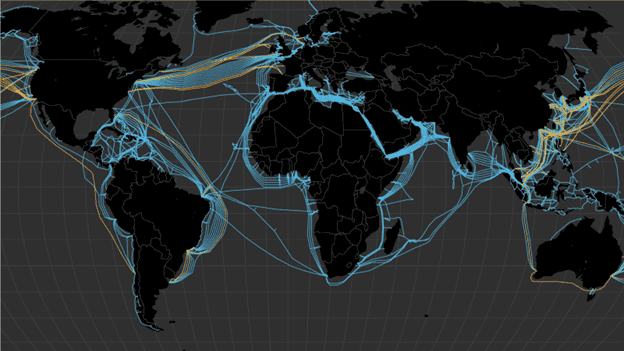
Source: https://medium.com/algorithm-and-datastructure/critical-connections-in-a-network-901a6165c068
Through improvements in the fiber itself, as well as in methods of transmitting light information, a single glass fiber the thickness of a human hair can now transmit 32 TB/s. That’s 32 trillion bytes of information—or about 6,800 DVDs worth of information—every second. Kapany coined the term “fiber optics” in a 1960 Scientific American article, and he wrote the first textbook for the field and was its most public spokesman. His success was undoubtedly influenced by the support and partnership of his wife, Satinder Kaur Kapany. The challenges of pioneering new technology and establishing himself in the scientific community required immense perseverance and resilience, which were bolstered by her steadfast encouragement.
Narinder Singh Kapany was born on October 31, 1926, in Moga, a small town in Punjab, India. His early life in pre-independence India was marked by natural curiosity and a passion for learning about the world around him. After completing his initial education at Agra University, in 1952 Kapany pursued higher studies in optics, which led him to Imperial College, London and to his future wife. Here, under the mentorship of British optics pioneer Harold Hopkins, he embarked on a journey that would change the world.
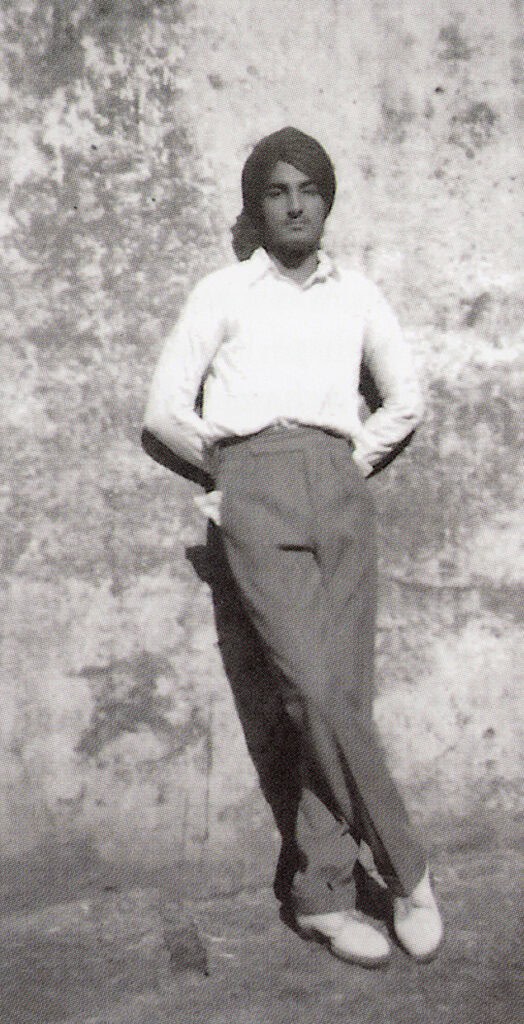
Narinder Kapany at Dehradun, India, at the foothills of the Himalayas, where he did his early schooling.
While working on his PhD at Imperial College under Hopkins in the early 1950s, Kapany conducted groundbreaking research on light transmission through fibers. At a time when the scientific community believed that light could not travel through bent structures, Kapany's experiments demonstrated otherwise: in 1953, he successfully transmitted light through bent glass fibers, proving that optical signals could indeed be guided along a curved path.
This breakthrough paved the way for the development of fiber optics, a technology that relies on the principle of total internal reflection to transmit light over long distances with minimal loss. Kapany's work laid the theoretical and practical groundwork for this technology, which would later become crucial for modern communication systems and most importantly the global data communications network knows as the internet.

Kapany determined that Total Internal Reflection was the key to long distance optical transmission of light. Source: https://www.coherent.com/news/glossary/optical-fibers
After completing his doctorate in 1955, the Kapanys moved to the United States, where Narinder continued his research and innovation and where he and Satinder had a son, Raj, and a few years later, a daughter, Kiki.
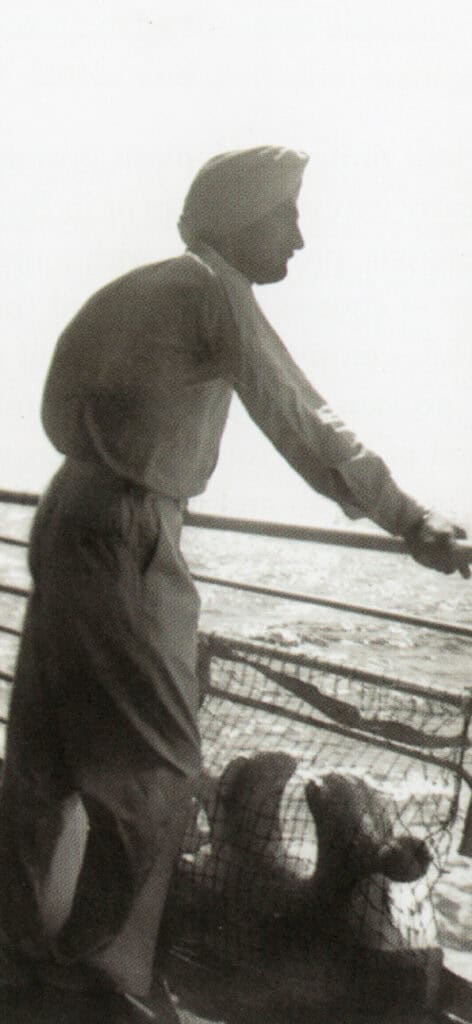
Coming to America: Kapany on his way to New York, 1955.
In 1960, Kapany founded Optics Technology, Inc. (OTI), in California, one of the first companies to commercialize fiber optic products. OTI made lenses, coatings and endoscopes for industrial and military markets and took the company public in 1967. Some of Silicon Valley’s very first and ultimately most influential venture capitalists provided early funding for OTI, including William Draper, Irwin Fetterman, and Tom Perkins.
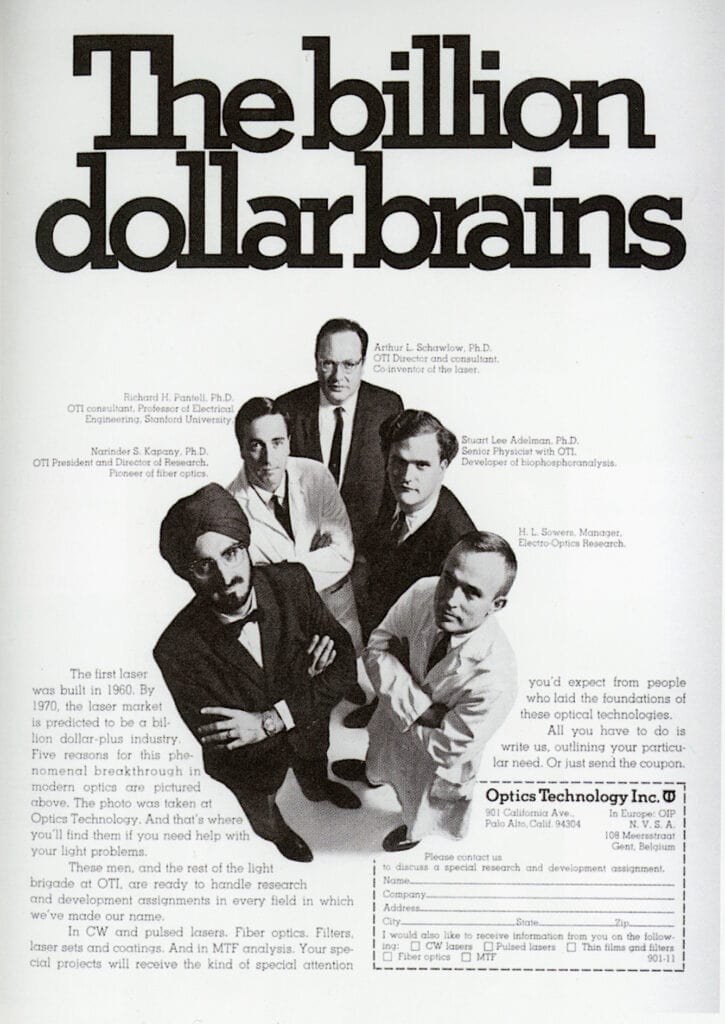
Early Optics Technology advertisement.
Kapany adopted an American accent, retaining just enough of his Indian and English tenor to make him stand out—an aptitude for code-switching that contributed to his success in both the science lab and the boardroom, according to his son Raj.
In 1977, Kapany started a new company, Kaptron, to specialize in ways of improving long distance fiber optic transmission for telephone and internet companies such as AT&T, Northern Telecom, and British Telecom. Kaptron was sold to connector giant AMP, and Kapany was made head of their 100-person R&D department, where he stayed for 10 years developing advanced photolithography materials and components.
Kapany's contributions extended beyond fiber optics. He held over 100 patents in various fields, including biomedical instrumentation, solar energy, and pollution monitoring. His innovations have had far-reaching impacts, influencing diverse sectors from telecommunications to medical diagnostics. Some of his inventions and products he improved upon include oximeters, laser coagulators, and endoscopes.
Throughout his career, his wife, Satinder Kapany, provided him with unwavering emotional and moral support. The challenges of pioneering new technology and establishing himself in the scientific community required immense perseverance and resilience, which were bolstered by her steadfast encouragement.
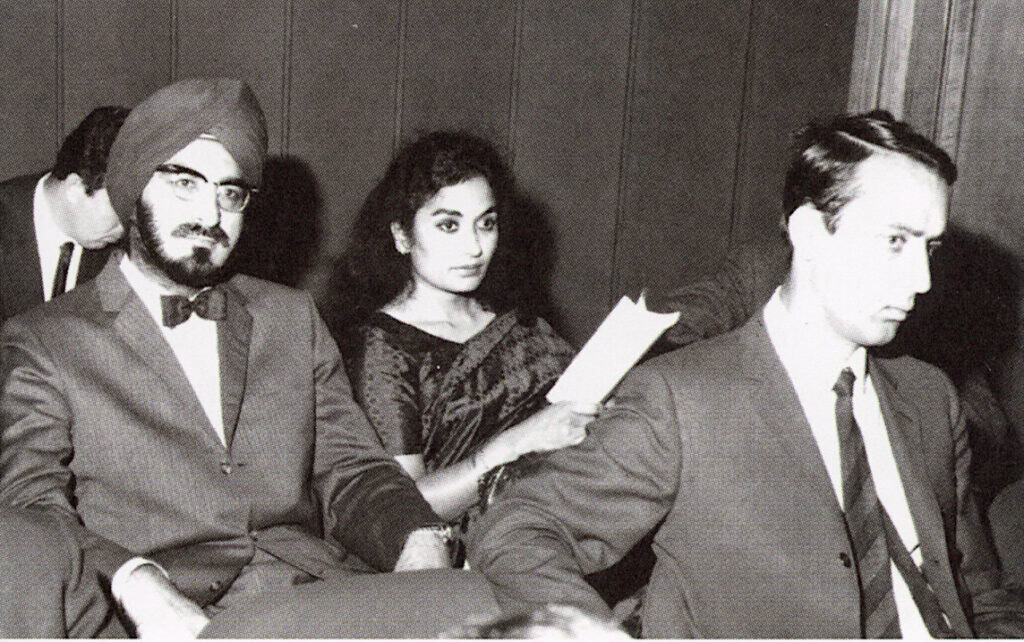
Satinder and Narinder Kapany at an optics conference in Florence, 1954.
Kapany was also a dedicated educator and evangelist for fiber optics. While he did not win the Nobel Prize for the invention of fiber optics, he was its most public face, speaking and writing widely on the topic.
Kapany’s career, which blended business, academia and scientific research, included professorships at the University of California, Berkeley, and the University of California, Santa Cruz. He endowed university chairs at both those universities as well as University of California, Irvine and Santa Barbara. His teaching, research, and generous funding support for students and departments, inspired a generation of scholars, scientists and engineers, many of whom have made significant contributions to the field of optics.
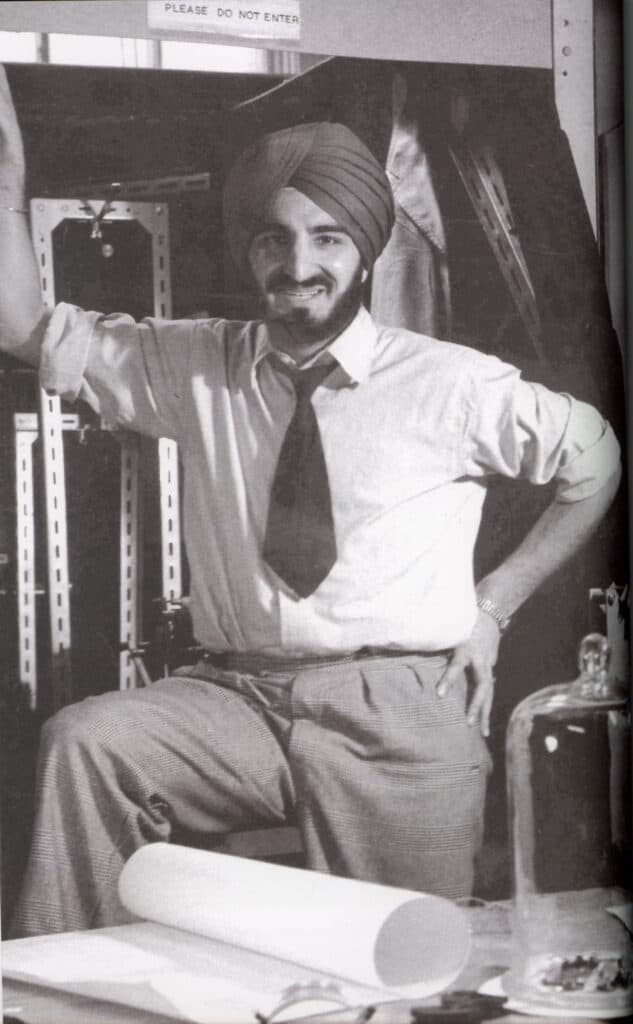
Narinder in his research lab at Imperial College.
The Kapanys were committed philanthropists and cultural ambassadors. They founded the Sikh Foundation in 1967, aimed at promoting the rich heritage and culture of Sikhism. Through this foundation, they supported various educational and cultural initiatives, including scholarships, exhibitions, and publications. The Kapanys also played a crucial role in establishing the Sikh art collection at the Asian Art Museum in San Francisco. Their efforts ensured that the art and history of the Sikh community received recognition and appreciation on a global scale.
Despite his important contributions, Narinder Kapany did not always receive the recognition he deserved. However, over the years, his work has been acknowledged by various prestigious institutions. He was named one of seven "Unsung Heroes" by Fortune magazine in their "Businessmen of the Century" issue in 1999. He was also honored with the Pravasi Bharatiya Samman by the Government of India in 2004, recognizing his outstanding contributions to science and technology.
Narinder Singh Kapany's life demonstrates the power of ideas, of invention, faith, and perseverance. His pioneering work in fiber optics transformed the way the world exchanges information and established the basic principles and technical foundation for the undersea cable network of fiber optic cables that form today’s Internet. Narinder Kapany may be an unsung hero, a “hidden figure,” but his impact on the world is enduring. He passed away on December 4, 2020 at the age of 94.
Kapany, Narinder, The Man Who Bent Light: Father of Fiber Optics, Roli Books, New Delhi, 2022. Amazon.
Hopkins, H., Kapany, N. A Flexible Fibrescope, using Static Scanning. Nature 173, 39–41 (1954). https://doi.org/10.1038/173039b0
Kapany, N. High-Resolution Fibre Optics Using Sub-Micron Multiple Fibres. Nature 184, 881–883 (1959). https://doi.org/10.1038/184881a0
Kapany, N. Optical Image Assessment. Nature 188, 1083–1086 (1960). https://doi.org/10.1038/1881083a0
Capellaro, D., Kapany, N. & Long, C. A Hypodermic Probe using Fibre Optics. Nature 191, 927–928 (1961). https://doi.org/10.1038/191927a0
Kapany, N., Peppers, N., Zwing, H. et al. Retinal Photocoagulation by Lasers. Nature 199, 146–149 (1963). https://doi.org/10.1038/199146a0
Kapany, Narinder, “Fiber Optics,” Scientific American, November, 1960.
Kapany, N.S., Light Transmitters: Fiber Optics. Principles and Applications, Academic Press, New York, 1967.
The Sikh Foundation, 580 College Ave, Palo Alto, Calif 94303.